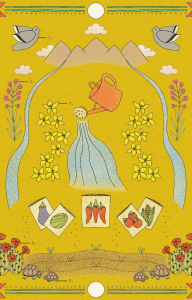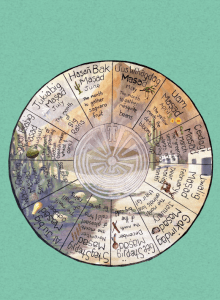This blog post about the newly released Sonoran Desert School Gardener's Almanac features an introduction by the Seed Library Team and a guest article authored by Moses Thompson, Director of the UA School Garden Workshop (SGW) and author of the Almanac's foreword.
There are about a million and one things to love about our desert home and one of those things near to our heart is the nationally recognized School Garden Workshop (SGW). The SGW has become a model for hands-on, ecologically-centered education that empowers students see connections between the myriad systems we navigate as humans. The program also uplifts and celebrates student learners as knowledge sharers. One of those demonstrations of knowledge sharing is The Sonoran Desert School Gardener’s Almanac, a collaboration between students and other community knowledge sharers and a Top Pick in the 2023 Southwest Books of the Year publication.
The Seed Library Team is excited to help more widely share this lovingly gathered collection of traditional knowledge with the library community—you can find copies of the almanac available for you to check out at your local library!
School Gardens are Powerful Connectors
by Moses Thompson
School gardens are powerful connectors. School gardens connect learners with the natural world, healthy eating and food systems, and connect classroom learning to the real world. In school gardens, students can use math to measure, track inputs and outputs, and look at patterns. Students can read and write procedural and nonfiction text to improve their gardening, pass knowledge on to others, and document progress. Fundamentally, school gardens bring joy to the school day and cultivate a love of learning.
But what if school gardens did more?
- What if school gardens had the power to connect students to cultural heritage and culinary traditions?
- What if school gardens were a floodgate for community knowledge to flow into K-12 school buildings?
- What if school gardens could work as a mirror for students to see themselves and their families reflected in their education?
What if the culmination of the above aspirations led students to see themselves as having agency in a world of grand challenges?
For us with the University of Arizona’s School Garden Workshop those what ifs are what drive our work, and The Sonoran Desert School Gardener’s Almanac is a tool to help get us there. The Almanac is a love note to the Sonoran Desert, its people, and its food heritage. The Almanac is an outpouring of love from big learners to little learners, of place, a love of natural systems, and a love of cultural heritage. The Almanac is a handbook celebrating cycles; cycles of the moon intersect with cycles of Sonoran Desert seasons. Local knowledge holders pass on heritage to learners who themselves become knowledge holders.
The Almanac is a hyper place-based gardening handbook color coded by Sonoran Desert seasons. Between its pages you’ll find calendars, garden tips and tricks, recipes, remedies, traditional knowledge, art, and poetry. Each author is a local knowledge holder living in the communities we serve. Contributors are parents, grandparents, teachers, and friends. Themes of social and emotional learning, natural systems, and cultural heritage weave a thread across each entry.
With intention, school gardens do much more than grow food. School gardens grow love of place and connectedness between people. The Sonoran Desert School Gardener’s Almanac is a handbook for grounding learners in this amazing place and giving voice to the knowledge holders who inhabit it.
Check out this 3-minute video introduction to the Almanac and some of its contributors!




